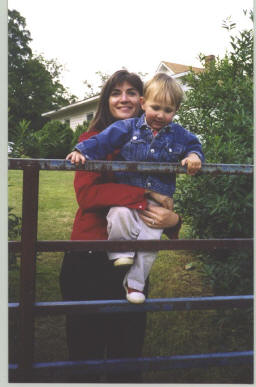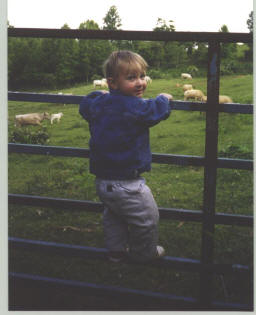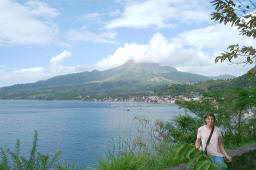G. Matthew Fricke
Bio
I am a Research Associate Professor of Computer Science at the University of New Mexico, where I study computation in complex decentralised systems like supercomputing clusters, robot swarms, social insects, and immune systems. I also have an interest the ethics of artificial systems and complexity measures as biosignatures. Through the Center for Advanced Research Computing I collaborate with scientists from a variety of disciplines to scale up their computations to supercomputers. I enjoy teaching whenever I can and mentoring students.
I earned a BA in Anthropology (Archaeology) from Appalachian State University; and a BS in Mathematics, and MS (Artificial Intellignce) and PhD degrees in Computer Science from the University of New Mexico. Through my consulting company, Go Figure Software, I've supported researchers in the UNM Physics and Los Alamos National Labs with custom scientific software.
My wife, Suzanne, and I have four boys: Henry, Leo, Owen, and Tristan. We live in Albuquerque, New Mexico, USA. I was born and raised in Shrewsbury, UK, but have lived in Mount Airy, North Carolina and Albuquerque, New Mexico for most of my life. I have been interested in computers since playing with a BBC Computer when I was nine years old.
I came to New Mexico for Harvard Ayers' southwest field school and stayed to work for the Park Service at Petroglyph National Monument.Office Schedule
Book an appointment.Teaching
Courses
CS491/591: High Performance Computing
CS533: Experimental Methods in Computer Science
CS591: Programming Swarm Robots
CS523: Complex Adaptive Systems
CS261: Mathematical Foundations of Computer Science
CS151: Computer Programming Fundamentals with Python
CS151: Computer Programming Fundamentals with C++
HPC Workshops
General HPC and SLURM
Beginner Introduction: Basic Linux and Interactive SLURM
Intermediate Introduction: Batch SLURM with FORTRAN
Intermediate Introduction: Batch SLURM with Python
Intermediate Intro to SLURM
Intermediate Intro to SLURM with NAMD
SLURM and Gaussian (1 hr version)
Intermediate SLURM and StarCCM
PBS, Modules, GNU Parallel, Conda, and MPI
Parallel Processing with MPI and SLURM (50 min version)
Computer Science and Math
CS4/542: Introduction to Parallel Processing
CS523: Complex Adaptive Systems
Computer Science/Math 471: Introduction to Scientific Computing
Discipline-Specific
Chemistry 525: Structural Biology – Crystallography and CARC
Biology 4/519: Biodiversity Informatics
Chemistry 567 / Physics 581 / ECE 595: Quantum Computing for Quantum Chemistry
Environmental Sciences 352: Global Climate Change
Earth and Planetary Sciences 400/522: Computational Methods for Geoscience
Intermediate Introduction with Radio Astronomy and CASA
Scientific Computing Lecture (CS471, 2018)
Computational Fluid Dynamics
Quantum Computing
Special Events
CARC Annual Meeting: Machine Learning
ESCAPE Workshop with JupyterHub
General CARC Introductions (Older Versions)
CARC Workshop v1.5
CARC Workshop v1.1
CARC Workshop v1.4
Bits and Pieces
CS152: Computer Programming Fundamentals with Java
CS201: Discrete Mathematics
CS251: Intermediate Programming with Java
CS523: Complex Adaptive Systems (Spring 2013)
Q-bio (Summer 2018) (Models Lecture)
CARC CS/Math471: Introduction to Scientific Computing (HPC Lecture)
Coding for Beginners
Publications
White Papers
Comment on Docket No. FR-6111-P-02: HUD's Implementation of the Fair Housing Act's Disparate Impact Standard. S. Gipson Rankin, A. Mathewson, M. Moses, G. M. Fricke, et al. PDF
Community Report from the Biosignatures Standards of Evidence Workshop. V. Meadows, H. Graham, G. M. Fricke, et al. PDF
Book Chapters
"Using RuleBuilder to graphically define and visualize BioNetGen-language patterns and reaction rules." Suderman, Ryan, G. Matthew Fricke, and William S. Hlavacek, In: Hlavacek W. (eds) Modeling Biomolecular Site Dynamics. Methods in Molecular Biology, vol 1945. Humana Press, New York, NY, 2019. PDF
"Ant Colonies as a Model of Human Computation", Melanie Moses, Tatiana Flanagan, Kenneth Letendre and G. Matthew Fricke, In: Handbook of Human Computation, Springer, 2014. website
Journals
More is Faster: Why Population Size Matters in Biological Search. Janatul Ferdous, G. Matthew Fricke, and Melanie Moses., Journal of Computational Biology (2024), PDF
CO2 emissions during the 2023 Litli Hrtur eruption in Reykjanes, Iceland: 13C tracks magma degassing.Tobias Fischer et al. Bulletin of Volcanology (2024), Web, PDF
Sensor Equipped UAS for Non-Contact Bridge Inspections: Field Application. Roya Nasimi, Fernando Moreu, and G. Matthew Fricke., Sensors (2023), PDF
Aerial Survey Robotics in Extreme Environments: Mapping Volcanic CO2 Emissions With Flocking UAVs. John Erickesen et al., Frontiers in Control Engineering, https://doi.org/10.3389/fcteg.2022.836720 (2022). Web, PDF
The Grayness of the Origin of Life. Hillary H. Smith et al., Life, 11, 498. https://doi.org/10.3390/life11060498 (2021). Web, PDF
Machine learning feature analysis illuminates disparity between E3SM climate models and observed climate change. Nichol, J. Jake, Matthew G. Peterson, Kara J. Peterson, G. Matthew Fricke, and Melanie E. Moses. Journal of Computational and Applied Mathematics (2021): 113451. Web, PDFAerial strategies advance volcanic gas measurements at inaccessible, strongly degassing volcanoes. Emily. J. Liu et al. Science Advances, (2020) Vol. 6, no. 44, eabb9103, DOI: 10.1126/sciadv.abb9103. PDF
Swarm Foraging Review: Closing the Gap Between Proof and Practice. Qi Lu, G. Matthew Fricke, John C. Ericksen, and Melanie E. Moses Current Robotics Reports (2020): 1-11. PDF
Variability in the Analysis of a Single Neuroimaging Dataset by Many Teams. Rotem Botvinik-Nezer et al. Nature (2020). Paper
Modeling T Cell Motion in Tissues During Immune Responses. Cannon, Judy, Melanie E. Moses, Janie R. Byrum, Paulus Mrass, G Matthew Fricke, and Humayra Tasnim. In: Biophysical Journal 116 (Feb. 2019), 322a. doi: 10.1016/j.bpj.2018.11.1749.
Quantitative Measurement of Naïve T cell Association with Dendritic Cells, FRCs, and Blood Vessels in Lymph Nodes., Tasnim, Humayra, G. Matthew Fricke, Janie R. Byrum, Justyna O. Sotiris, Judy L. Cannon, and Melanie E. Moses. Frontiers in immunology 9 (2018). PDF
ROCK regulates the intermittent mode of interstitial T cell migration in inflamed lungs. Paulus Mrass, Sreenivasa Oruganti, G. Matthew Fricke, Justyna Tafoya, Janie Byrum , Lihua Yang, Samantha Hamilton, Mark Miller, Melanie Moses and Judy Cannon. Nature Communications (2017)
Persistence and Adaptation in Immunity: T Cells Balance the Extent and Thoroughness of Search. Fricke, G. Matthew, Kenneth A. Letendre, Melanie E. Moses, and Judy L. Cannon. PLoS Computational Biology 12.3 (2016): e1004818. PDF
Immune-inspired search strategies for robot swarms. G. Matthew Fricke, Joshua Hecker, Judy Cannon, and Melanie Moses. Robotica 34, no. 08 (2016): 1791-1810. Cambridge Press. PDF
Quantifying the Effect of Colony Size and Food Distribution on Harvester Ant Foraging, Tatiana P. Flanagan, Kenneth Letendre, William R. Burnside, G. Matthew Fricke, and Melanie E. Moses, PLoS ONE, 2012. PDF
GetBonNie for building, analyzing, and sharing rule-based models, Bin Hu; G. Matthew Fricke; James R. Faeder; Richard G. Posner; William S. Hlavacek Bioinformatics 2009, Oxford Journals
Receptor aggregation by intermembrane interactions: A Monte Carlo study G. Matthew Fricke; James L. Thomas Biophysical Chemistry Volume 119, Issue 2, 20 Jan 2006; Pages 205-211. PDF
Conference Proceedings
Navigating the Edge: UAS Boundary Tracing for Efficient Volcanic Plume Monitoring John Ericksen et al. IEEE International Symposium on Safety, Security, and Rescue Robotics (SSRR) (2024), PDF
A Bio-Inspired Transportation Network for Scalable Swarm Foraging, Qi Lu, G. Matthew Fricke, Takaya Tsuno, and Melanie E. Moses, In 2020 IEEE/RSJ International Conference on Intelligent Robots and Systems, IEEE Press, 2020.
LoCUS: A loss-tolerant volcano survey algorithm, Ericksen John, Abhinav Aggarwal, G. Matthew Fricke, and Melanie E. Moses, IEEE Robotics and Computing Conference (IRC) (2020)
Ignorance is Not Bliss: An Analysis of Central-Place Foraging Algorithms, Abhinav Aggarwal, Diksha Gupta, William F. Vining, G. Matthew Fricke, and Melanie E. Moses, In 2019 IEEE/RSJ International Conference on Intelligent Robots and Systems, IEEE Press, 2019. Paper PDF, Presentation PDF
Comparing physical and simulated performance of a deterministic and a bio-inspired stochastic foraging strategy for robot swarms, Lu, Qi, Antonio D. Griego, G. Matthew Fricke, and Melanie E. Moses., In 2019 IEEE/RSJ International Conference on Robotics and Automation, IEEE Press, 2019.
Brief Announcement: On Site Fidelity and the Price of Ignorance in Swarm Robotic Central Place Foraging Algorithms, Abhinav Aggarwal, G. Matthew Fricke, Diksha Gupta, and Melanie Moses. In Symposium on Principles of Distributed Computing (PODC), ACM Press, 2019, https://doi.org/10.1145/3293611.3331572. PDF
A Distributed Deterministic Spiral Search Algorithm for Swarms. G. Matthew Fricke, Joshua P. Hecker, Antonio D. Griego, Linh T. Tran, and Melanie Moses. In 2016 IEEE/RSJ International Conference on Intelligent Robots and Systems, IEEE Press, 2016. . PDF
Distinguishing Adaptive Search From Random Search in Robots and T cells, G. M. Fricke, J. P. Hecker, S. R. Black, J. L. Cannon, M. E. Moses, in Proceedings of the Conference on Genetic and Evolutionary Computation, Association for Computing Machinery, 2015.
From Microbiology to Microcontrollers: Robot search patterns inspired by T cell movement, G. Matthew Fricke, Francois Asperti-Boursin, Joshua P. Hecker, Cannon Judy L., and Melanie E. Moses. Proceedings of the 12th European Conference on Artificial Life, The MIT Press, 2013. Paper
How Ants Turn Information into Food, T. Paz Flanagan, K. Letendre, W. Burnside, G. M. Fricke, M. Moses, in IEEE SSCI 2011 - Symposium Series on Computational Intelligence - IEEE Symposium on Artificial Life (2011), pp. 178–185. PDF
Emergent Representation in a Robot Control Architecture, Claiborne, Andy., Fricke, G. Matthew., Lopes, L., Lewis, Joseph., and Luger, George, UNM-NASA PURSUE Conference, (2000).
White Papers
UNM News Articles:
Selected news articles covering Matthew Fricke's research, mentorship, and collaborative projects.
VolCAN: Volcanic Drone Research
UNM's VolCAN Team Makes History in Canary Islands
Covers the team's deployment of autonomous drones to sample volcanic gases during an eruption, providing insights into plume dynamics and eruption forecasting.
Engineering in Action Features Project VolCAN
Highlights how the VolCAN project evolved from earlier Swarmathon work, including technical development and field deployment.
NASA Robotics Challenges
UNM Team Qualifies for Second Phase of NASA Robotics Challenge
NASA's robotics challenge, focused on autonomous lunar resource collection.
CHILI HOUSE: Autonomous Space Agriculture
Could Plants Control Robots on Mars?
Describes the CHILI HOUSE project, where we developed robotic gardeners for extraterrestrial plant cultivation.
Partnering for Success: NASA and Supercomputing Competitions
Mentoring interdisciplinary student teams in NASA and HPC competitions.
SIMReef: Reef Modelling and Environmental Computing
UNM Researchers Take a Deep Dive into Our Changing Planet with SIMReef Project
HPC-based modelling of coral ecosystems informed by field data.
HPC Student Mentorship
UNM Competes in HPC Student Cluster Competitions
Student teams in the Winter Classic and Supercomputing Student Cluster Competitions.
CARC Team Travels to Denver for Supercomputing Conference
Recruitment and mentoring of students for the SC23 conference and the HPC Winter Classic Invitational.
Student Theses and Dissertations
PhD Dissertation: Jannatul Ferdous, Immune System through Computational Modeling: A Comprehensive Study of Lymph Nodes and Immune Response Scaling, Vaccine Efficacy, and Large-Scale Extreme First Passage Time, University of New Mexico, 2025. (PDF coming soon)
PhD Dissertation: John Ericksen, Aerial Robotic Studies of Volcanic CO2 Emissions, University of New Mexico, 2025. (PDF)
PhD Dissertation: Jake Nichol, Seeking Structure in Complex Systems: From Feature Analysis to Space-Time Causal Discovery with Earth Science Applications, University of New Mexico, 2025. (PDF coming soon)
PhD Dissertation: Humayra Tasnim, Insight Into Complexity: Novel Information Theoretic Analysis of Spatiotemporal Interactions, University of New Mexico, 2024. PDF
MS Thesis: Quincy Wofford, Reproducible Application Platforms for Distributed Computing Systems, University of New Mexico, 2023. PDF
Social Media
Facebook: https://facebook.com/gmfricke
YouTube channel: https://www.youtube.com/user/MatthewFricke
Google scholar profile: https://scholar.google.com/citations?user=hdPxTWwAAAAJ&hl=en
PGP Key
Pretty Good Privacy Email Key: http://fricke.co.uk/pgppublickey.txt
Photographs
(posted here before social media was a thing) Europe 2008Tikal, Guatemala
Monaghan, Ireland
New Mexico
Mt. St. Helens, Oregon
North Carolina
San Deigo, California
Yr Wyddfa (Snowdon) and Anglesey, Wales
Shrewsbury, England
Charles Darwin's Childhood Home
Edinburgh, Scotland
Teotihuican, Mexico
Japan
Moscow, Russia
Martinique















_small.jpg)






